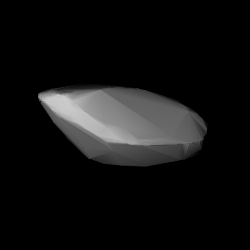Top Qs
Timeline
Chat
Perspective
1677 Tycho Brahe
Asteroid From Wikipedia, the free encyclopedia
Remove ads
1677 Tycho Brahe, provisional designation 1940 RO, is a stony Marian asteroid from the central region of the asteroid belt, approximately 12 kilometers (7.5 miles) in diameter. It was discovered on 6 September 1940, by Finnish astronomer Yrjö Väisälä at Turku Observatory in Southwest Finland.[1] The common stony S-type asteroid has a short rotation period of 3.89 hours.[5] It was later named after Tycho Brahe, one of the fathers of astronomy.[2]
Remove ads
Classification and orbit
When applying the hierarchical clustering method to its proper orbital elements, Tycho Brahe is a member of the Maria family (506),[4] a large family of stony asteroids.[11]: 23 Based on osculating Keplerian orbital elements, the asteroid has also been classified as a member of the Eunomia family (502), the largest family in the intermediate main belt with more than 5,000 members.[5]
It orbits the Sun in the central main-belt at a distance of 2.3–2.8 AU once every 4.03 years (1,472 days; semi-major axis of 2.53 AU). Its orbit has an eccentricity of 0.11 and an inclination of 15° with respect to the ecliptic.[3] The asteroid was first observed as A916 UA at Bergedorf Observatory in October 1916, extending the body's observation arc by 24 years prior to its official discovery observation at Turku.[1]
Remove ads
Physical characteristics
The asteroid has been characterized as a stony S-type by Pan-STARRS survey, and in the SDSS-MFB (Masi Foglia Binzel) taxonomy,[5][10][a] which agree with the overall spectral type for members of the Maria family.[11]: 23
Rotation period
In July 2012, a rotational lightcurve of Tycho Brahe was obtained by Renata Violante and Martha Leake, that gave a short rotation period of 3.89 hours with a brightness variation of 0.38 magnitude (U=2+).[5][9]
Diameter and albedo
According to the survey carried out by NASA's Wide-field Infrared Survey Explorer with its subsequent NEOWISE mission, Tycho Brahe measures 11.78 kilometers in diameter, and its surface has an albedo of 0.221 (revised 2014-figures).[8] The Collaborative Asteroid Lightcurve Link assumes an albedo of 0.21, derived from the family's largest member and namesake, 15 Eunomia, and calculates a diameter of 13.26 kilometers, based on an absolute magnitude of 11.7.[5]
Remove ads
Naming
This minor planet is named for the great Danish-born astronomer Tycho Brahe (1546–1601) an early forerunner and father of modern astronomy. He is known for his unprecedented precise measurements in the pre-telescopic era.[2] The official naming citation was published by the Minor Planet Center on 15 October 1977 (M.P.C. 4236).[12] Brahe is also honored by the prominent crater Tycho in the southern highlands of the Moon and by the Martian crater Tycho Brahe.[2] The bright supernova, SN 1572, is also known as Tycho's Nova.
Notes
- Search for Unusual Spectroscopic Candidates Among 40313 minor planets from the 3rd Release of the Sloan Digital Sky Survey Moving Object Catalog (publication). SDSS-MFB (Masi Foglia Binzel) taxonomy (catalog).
References
External links
Wikiwand - on
Seamless Wikipedia browsing. On steroids.
Remove ads

